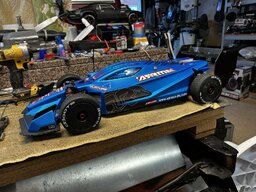If you are interested you can send me an STL file of the rear wing I should "test" and I include it in the sheet.
The maximum width of the wing is 30cm and I only tested the wing and its endplates. Without the mounts and a car.
All the simulations were made with the simscale free trail.
I ranked them by efficiency. If you have twice the efficiency you can get double the downforce for the same drag or half the drag while keeping the same downforce.
The numbers are at 35m/s or 126km/h air speed. And the wing is tested in free air, so if mounted on a car it will have less downforce and be less efficient.
The limitless wing does not have accurate dimensions, since I don't own one.
The 3D-printed airfoil wings can't replace a strong injection molded wing on a bashing rig. But for on-road cars, they could be interesting.
The front wing's effectiveness will be greatly reduced when attached in front of a car, which blocks and slows down the air behind the front wing.




The maximum width of the wing is 30cm and I only tested the wing and its endplates. Without the mounts and a car.
All the simulations were made with the simscale free trail.
I ranked them by efficiency. If you have twice the efficiency you can get double the downforce for the same drag or half the drag while keeping the same downforce.
The numbers are at 35m/s or 126km/h air speed. And the wing is tested in free air, so if mounted on a car it will have less downforce and be less efficient.
The limitless wing does not have accurate dimensions, since I don't own one.
The 3D-printed airfoil wings can't replace a strong injection molded wing on a bashing rig. But for on-road cars, they could be interesting.
The front wing's effectiveness will be greatly reduced when attached in front of a car, which blocks and slows down the air behind the front wing.
Last edited:


